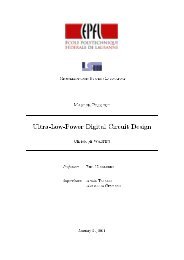Compressive Sensing system for recording of ECoG signals in-vivo
Compressive Sensing system for recording of ECoG signals in-vivo
Compressive Sensing system for recording of ECoG signals in-vivo
Create successful ePaper yourself
Turn your PDF publications into a flip-book with our unique Google optimized e-Paper software.
6.2. Mix<strong>in</strong>g and IntegrationFirst <strong>of</strong> all, the purposes <strong>of</strong> the re-design <strong>of</strong> the mix<strong>in</strong>g and <strong>in</strong>tegration blocks are: a) reduc<strong>in</strong>garea and b) implement<strong>in</strong>g together the mixer and the <strong>in</strong>tegrator, and not <strong>in</strong>tegrat<strong>in</strong>g as differentblocks. In order to study which are the limitations <strong>in</strong> per<strong>for</strong>mance and the eventual problemsthat have to be faced <strong>in</strong> the mixer-<strong>in</strong>tegrator design, several known models have beenimplemented and checked with<strong>in</strong> a multipath channel <strong>in</strong> Cadence, by tak<strong>in</strong>g <strong>in</strong>to considerationdifferent configurations <strong>for</strong> the <strong>in</strong>tegrator: passive, active and switched capacitors-based one.These topologies are <strong>in</strong>troduced below by us<strong>in</strong>g the technology TSMC018.6.2.1. Passive IntegrationA passive <strong>in</strong>tegrator is a simple four-term<strong>in</strong>al network consist<strong>in</strong>g <strong>of</strong> two passive elements, aresistor and a capacitor as it is <strong>in</strong>cluded <strong>in</strong> Fig.6.2.1.2. For each <strong>of</strong> the paths, <strong>in</strong>tegration iscarried out and the f<strong>in</strong>al <strong>in</strong>tegration value is obta<strong>in</strong>ed with a scale factor which depends on RCand the <strong>in</strong>tegration time. Thereby, the f<strong>in</strong>al output result accumulated <strong>in</strong> the <strong>in</strong>tegrator <strong>of</strong> eachpath is obta<strong>in</strong>ed as:(16)Where is the <strong>in</strong>tegration <strong>in</strong>terval, which corresponds to the <strong>in</strong>verse <strong>of</strong> the sampl<strong>in</strong>gfrequency, and so it is . The circuit <strong>in</strong> Fig.6.2.1.1 acts as a Low Pass Filter (LPF) <strong>for</strong>frequencies which are under the pole frequency, f p , which def<strong>in</strong>ed as (see Eq.17).Figure 6.5.1.1. Mixer and passive <strong>in</strong>tegrator circuitry.The circuit per<strong>for</strong>ms as <strong>in</strong>tegrator <strong>for</strong> <strong>in</strong>put <strong>signals</strong> whose frequency is over f p because <strong>of</strong> thefact that the constant <strong>of</strong> time <strong>of</strong> the <strong>in</strong>tegrator has to be larger than the period <strong>of</strong> the signal.Accord<strong>in</strong>g to this, the <strong>in</strong>tegrator has to be designed <strong>in</strong> order to fix the pole frequency below thefrequencies <strong>of</strong> <strong>in</strong>terest that have to be <strong>in</strong>tegrated.(17)55















